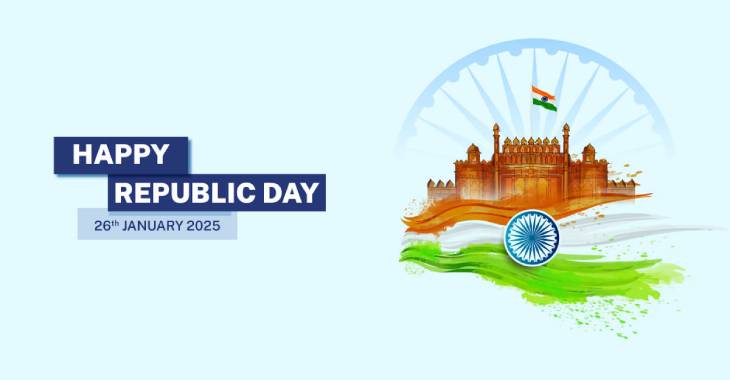Republic Day is one of the most significant national events in India, celebrated annually on January 26th. It marks the day the Constitution of India came into effect in 1950, making India a republic. One of the most anticipated aspects of the Republic Day celebrations is the grand parade held at the capital, New Delhi, where various states and organizations showcase their culture, history, and achievements through colorful and elaborate tableaux.
What is a Tableau?
A tableau is a decorative, artistic display on wheels, typically mounted on trucks, that showcases a theme or represents a particular aspect of culture, history, tradition, or achievements. It often includes a combination of elements like models, sculptures, performances, music, and dance. These tableaux are a central feature of Republic Day parades, and they represent the diversity, unity, and rich cultural heritage of India. Each state or union territory, along with different government departments, prepares a tableau that tells a story or highlights significant events, developments, or achievements in the region.
The tableaux are not just visually appealing but also convey a deeper message, often aimed at educating the public about India’s rich heritage and progress in various fields. Some of these might focus on achievements in science and technology, others on historical milestones, while others celebrate the diversity of Indian culture through traditional music, dance, and art forms.
How Are Tableaux Selected?
The selection process for Republic Day tableaux is quite detailed and involves multiple stages, ensuring that only the best representations of India’s diverse cultures, traditions, and achievements make it to the grand parade. Here’s how the selection process works:
- Theme Selection:
Each tableau must have a clear theme that either represents the culture, traditions, history, or progress of a state or union territory. This theme is the foundation of the tableau’s design. For example, a tableau might represent the state’s role in promoting renewable energy, the contributions of a local freedom fighter, or a cultural festival celebrated in that region. - Design Submission:
States and organizations interested in participating in the Republic Day parade need to submit detailed design proposals for their tableaux. These designs include everything from the concept to the layout, along with detailed plans for the models, decorations, and any performances that may accompany the tableau. - Evaluation by Committees:
A panel of experts and officials, including representatives from the Ministry of Defence and the Ministry of Culture, evaluate these proposals. The selection committee carefully examines each submission based on several criteria, such as:- Creativity and originality: The tableau should have a fresh and creative design that engages the audience.
- Cultural and historical significance: The theme should accurately represent the culture, history, or achievements of the region or the nation.
- Relevance: The tableau should reflect current issues or achievements that are important to the country’s progress or heritage.
- Aesthetic appeal: The artistic quality of the tableau is also evaluated, including how it is presented and how well it engages viewers.
- Technical feasibility: The committee also looks at how practical the design is to build and move in the parade.
- Shortlisting and Revisions:
After the initial review, a shortlist of tableaux is created. Some of the entries may require revisions to better fit the parade’s overall theme or improve the visual impact. States and organizations are given a chance to make necessary adjustments before final approval. - Final Selection:
Once the revisions are made, the final selection of tableaux is made. These are the ones that will participate in the Republic Day parade. In some cases, there are also special tableaux prepared by ministries and organizations to showcase national achievements in various fields such as science, technology, defense, and education. - Preparation and Rehearsals:
After the tableaux are selected, states and organizations begin the construction and final preparation of their displays. Teams work on the detailed construction of models, sculptures, and the overall structure. Rehearsals are conducted, especially for tableaux that involve performances or live acts. The organizers ensure that each tableau is ready and in its best shape for the parade day.
Features of Republic Day Tableaux
- Models and Sculptures:
Most tableaux are built around large models or sculptures that represent the core theme. These can be elaborate figures, buildings, or cultural symbols. For instance, a tableau might feature a model of a historical monument, a prominent leader, or a famous folk art. - Music and Dance:
Many tableaux are accompanied by traditional music and dance performances. These live performances enhance the theme of the tableau and give it a dynamic, interactive aspect. In some cases, these performances may include local folk dances, songs, or even dramatizations of historical events. - Artistic Decorations:
The tableaux are decorated with vibrant colors and intricate designs, often reflecting the local culture and craftsmanship of the participating state or region. Artists use various materials like fabric, wood, and metal to create visually striking displays. - Representation of Achievements:
Many tableaux highlight achievements in fields like agriculture, science, technology, health, education, and environmental sustainability. For example, a tableau might highlight a state’s role in the promotion of renewable energy, or another might showcase a community’s efforts in improving literacy rates. - National Unity:
Although the tableaux represent individual states, they all convey a sense of national unity. The Republic Day parade is a celebration of India’s diversity and strength, and each tableau emphasizes how different cultures and regions contribute to the progress of the nation as a whole.
Notable Tableaux From Previous Republic Days
- Madhya Pradesh’s Tableaux on Tribal Art: In past years, Madhya Pradesh’s tableau has often showcased its rich tribal culture and art forms, featuring tribal dancers and artistic representations of the state’s traditional crafts.
- Karnataka’s Tableau on Historical Figures: Karnataka has frequently showcased tableaux that highlight its historical leaders, temples, and architectural marvels, reflecting its rich cultural and religious heritage.
- Ministry of Defence Tableaux: The Ministry of Defence regularly presents tableaux highlighting India’s military achievements, defense technology, and the bravery of the armed forces. These are typically accompanied by live displays from military personnel.
- Punjab’s Tableaux on Agriculture and Folk Traditions: Punjab’s tableau has often focused on its agricultural heritage, showcasing its contributions to India’s food security, while also celebrating its rich folk music and dance traditions.
Why Are Tableaux Important?
The tableaux are not just artistic expressions; they play a significant role in shaping national pride and unity. Republic Day is an opportunity for Indians to showcase their cultural diversity, historical milestones, and contemporary achievements. Through the tableaux, people across the country get to learn about each other’s regional cultures, contributions, and innovations.
The Republic Day parade, and specifically the tableaux, is a reminder of how the country has evolved and how every part of India, from the smallest village to the largest city, contributes to the nation’s greatness. It also serves as a platform to educate people about national heritage and achievements while promoting unity in diversity.
Conclusion
The tableaux are an integral part of Republic Day celebrations, offering a glimpse into the vibrant culture, rich history, and collective achievements of India. Through their selection, design, and presentation, the tableaux reflect the diversity of the nation while fostering a sense of unity. Whether highlighting regional traditions or national accomplishments, the tableaux play a vital role in showcasing the strength, resilience, and progress of India.
So, as Republic Day 2025 approaches, the nation eagerly awaits another grand parade, where states and organizations will come together to celebrate India’s incredible journey toward progress, harmony, and unity.
Read More
The 7 Most Famous Historical Monuments in Sri Lanka
The Top 10 Destinations and Attractions in Coonoor in 2024


